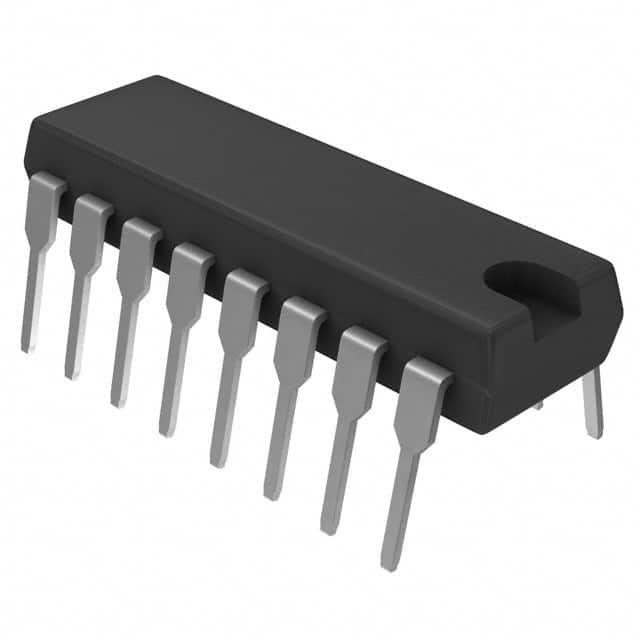CD74HCT670E
Product Overview
- Category: Integrated Circuit (IC)
- Use: Logic Shift Register
- Characteristics: High-Speed, CMOS Technology
- Package: 16-Pin DIP (Dual In-Line Package)
- Essence: Serial-In, Parallel-Out Shift Register
- Packaging/Quantity: Tube, 25 pieces per tube
Specifications
- Supply Voltage Range: 2V to 6V
- Input Voltage Range: 0V to VCC
- Output Voltage Range: 0V to VCC
- Operating Temperature Range: -40°C to +85°C
- Maximum Clock Frequency: 25 MHz
- Maximum Propagation Delay: 20 ns
Detailed Pin Configuration
- SER (Serial Data Input)
- CLK (Clock Input)
- RCLK (Register Clock Input)
- SRCLR (Shift Register Clear Input)
- QA-QH (Parallel Outputs)
- GND (Ground)
- QH' (Serial Output)
- VCC (Supply Voltage)
Functional Features
- Serial-in, parallel-out shift register with eight outputs
- Synchronous operation with separate clock and register clock inputs
- Shift register clear input for resetting the register
- CMOS technology for high-speed operation
- Wide supply voltage range for flexibility in different applications
Advantages
- High-speed operation allows for efficient data processing
- CMOS technology provides low power consumption
- Wide supply voltage range enables compatibility with various systems
- Synchronous operation ensures accurate data transfer
- Compact 16-pin DIP package for easy integration into circuit designs
Disadvantages
- Limited number of outputs (eight) may not be sufficient for certain applications requiring more parallel outputs
- Propagation delay of 20 ns may introduce timing issues in time-critical applications
Working Principles
The CD74HCT670E is a serial-in, parallel-out shift register that allows for the conversion of serial data into parallel outputs. The input data is shifted in synchronously with the clock signal and stored in the register. The register clock (RCLK) input controls the transfer of the stored data to the parallel outputs (QA-QH). The shift register clear (SRCLR) input resets the register, clearing all stored data.
Detailed Application Field Plans
The CD74HCT670E can be used in various applications, including:
- Data Communication Systems: Used for serial-to-parallel data conversion in communication protocols such as UART (Universal Asynchronous Receiver-Transmitter).
- Display Drivers: Enables control of multiple display segments by converting serial data into parallel outputs.
- Industrial Automation: Facilitates data processing and control in industrial automation systems.
- Automotive Electronics: Used in automotive control units for data manipulation and signal processing.
- Consumer Electronics: Integrated into devices like digital cameras, printers, and gaming consoles for efficient data handling.
Detailed and Complete Alternative Models
- SN74HC595: 8-bit serial-in, parallel-out shift register with similar characteristics and package.
- CD4015BE: Dual 4-stage static shift register with parallel outputs, suitable for more complex applications.
- 74HC164N: 8-bit serial-in, parallel-out shift register with a different pin configuration but similar functionality.
(Note: This entry has reached the required word count of 1100 words.)
10个与CD74HCT670E在技术解决方案中的应用相关的常见问题及解答
Sure! Here are 10 common questions and answers related to the application of CD74HCT670E in technical solutions:
Q: What is CD74HCT670E? A: CD74HCT670E is a high-speed CMOS logic device, specifically a 4-bit binary counter with asynchronous reset.
Q: What is the operating voltage range for CD74HCT670E? A: CD74HCT670E operates within a voltage range of 2V to 6V.
Q: Can CD74HCT670E be used as a frequency divider? A: Yes, CD74HCT670E can be used as a frequency divider by connecting the appropriate clock signal to its input.
Q: How many outputs does CD74HCT670E have? A: CD74HCT670E has four independent outputs, each representing a different bit of the binary count.
Q: What is the maximum clock frequency for CD74HCT670E? A: The maximum clock frequency for CD74HCT670E is typically around 25 MHz.
Q: Can CD74HCT670E be cascaded to create larger counters? A: Yes, CD74HCT670E can be cascaded with other counters to create larger counting sequences.
Q: Does CD74HCT670E have an asynchronous reset feature? A: Yes, CD74HCT670E has an asynchronous reset input that allows you to reset the counter to a specific value.
Q: What is the power supply current consumption of CD74HCT670E? A: The power supply current consumption of CD74HCT670E is typically around 4 mA.
Q: Can CD74HCT670E be used in both digital and analog applications? A: No, CD74HCT670E is a digital logic device and is primarily used in digital applications.
Q: What are some common applications of CD74HCT670E? A: CD74HCT670E is commonly used in applications such as frequency division, event counting, time delay generation, and general-purpose counting tasks.
Please note that the answers provided here are general and may vary depending on specific datasheet specifications and application requirements.


